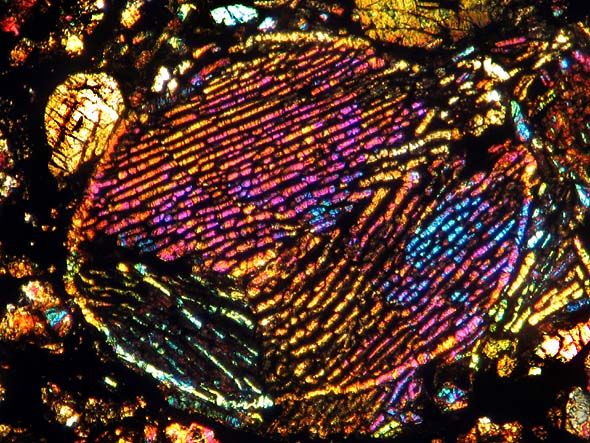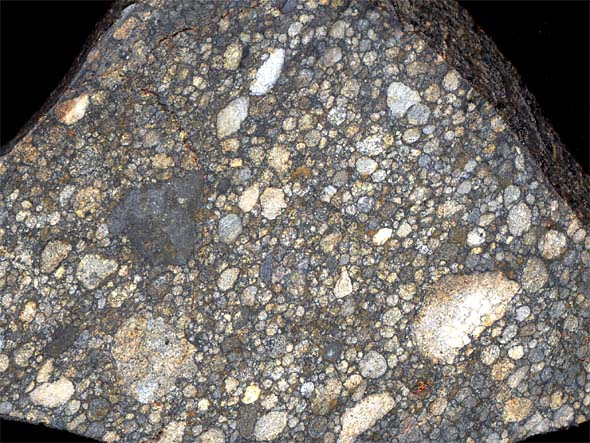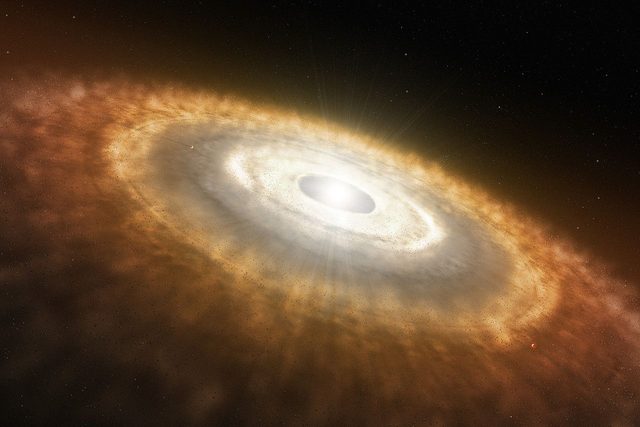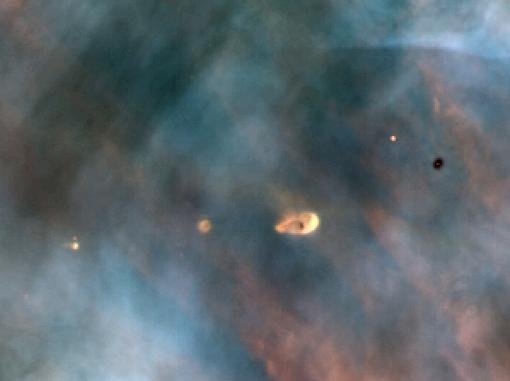Chondrites are both the most common and the most important type of meteor to science. Chondrites are nonmetallic stony meteors whose parent bodies never underwent melting or differentiation- essentially, they're largely unchanged in composition and structure from the early days of the solar system. They give us an unrivaled view of the early history of the Sun and the worlds orbiting it.

A thin section view of a barred olivine chondrule from meteorite Begaa NWA 4910 LL3.1 viewed through the cross polar light (xpl) mode of a mineralogical microscope. [Image source]
The study of meteorites is intensely detail oriented- a meteorite researcher (usually a geologist, though there are chemists and physicists who participate as well) will often spend weeks or months poring over a single meteor slice (a thin section) through a geological microscope. They'll record the structures, the minerals, the deformation, and a host of other details about the internal structure of the meteor. (I've done this, it's exhausting and the microscope gives me a headache. I did it on a type of meteor known as ureilite, however, not a chondrite.) They'll then run the sample through various chemical tests.
One of the most interesting results that crop up in chemical analysis of chondritic meteors is their remarkable similarity to the gross elemental makeup and chemical similarity to the sun. It only differs in the lighter elements- notably lithium. This, however, is explained by the fact that lithium isn't generated in the sun- it was only generated shortly after the Big Bang- and the sun tends to destroy it over time. So chondrites have the chemical composition of the sun from long ago. Specifically, from before the sun was born. They're more like the sun than the sun is.

The meteorite Begaa NWA 4910 LL3.1 viewed with the naked eye. [Image source]
This is because chondrites are remnants of the pre-solar dust cloud that the whole solar system formed out of. For a long time the dust cloud just floated in place, since it wasn't dense enough to collapse into a star on its own. Then something changed, and the whole thing began to collapse and coalesce. The leading hypothesis is that the dust cloud was struck by the supernova blast wave of an older star. This hypothesis is backed by chemical analyses- among other proof, chondrites have a large amount of a specific aluminum isotope that is only formed in supernovas. The variations in the composition of the dust cloud would be echoed in the variations in the planets that formed in various regions of the cloud.
Before the planets formed, of course, there was a long period of countless chaotic fragments slamming into one another, melting into a larger body, then being shattered again. The early stages of coalescence, when the Sun was just starting to form, was known as a protoplanetary disc or planetary nebula. Scientists most often refer to them as proplyds.

An artist's impression of a protoplanetary disc. [Image source]
Inside of chondrites are smaller, sand sized or smaller chunks known as chondrules. These rounded grains started off as partially molten droplets in space, and were then accreted into asteroids and other large bodies. The early solar system was filled with a fiery rain of these still molten chondrules. Chondrules are, in a very real sense, the basic building blocks of the solar system. Everything in the solar system is formed from them, but in everything other than chondrites, various chemical, physical, and temperature related processes have altered the chondrules beyond recognition. Like the chondrites to which they belong, chondrules give us an amazing window into the early days of our solar system.
Of course, you can go even farther back in time with materials found in chondrites, to well before the formation of the solar system began. Presolar grains are bits of stardust that got blown into the dust cloud that would become our solar system by the solar winds. They're usually found in the matrix of the chondrites (essentially, the 'cement' between the mineral grains and chondrules), and presolar grains can be differentiated from 'solar' grains by their different isotopic composition. Getting them out, frustratingly, requires the dissolution of the matrix rock via acid or other means.

Protoplanetary discs in the Orion Nebula. We've found more proplyds in the relatively young Orion Nebula than anywhere else. [Image Source]
Comparing the composition of presolar grains and chondrules gives us our absolute best evidence for use in explaining stellar evolution- even over the visual observation of stellar objects our many telescopes do. They're our best teacher about the early solar system. All of us- every planet, every plant, every animal, every rock in the solar system (excepting presolar grains) are from Earth. That fiery rain from the dawn of the solar system gave birth to us all.
Bibliography:
https://en.wikipedia.org/wiki/Presolar_grains#In_meteoritics
https://en.wikipedia.org/wiki/Stellar_evolution
https://en.wikipedia.org/wiki/Cosmic_dust#Stardust
https://en.wikipedia.org/wiki/Formation_and_evolution_of_the_Solar_System#Formation_of_the_planets
https://en.wikipedia.org/wiki/Chondrule#Formation
https://en.wikipedia.org/wiki/Chondrite
https://en.wikipedia.org/wiki/Proplyd
https://en.wikipedia.org/wiki/Protoplanetary_disk
My notes from my Meteorites and Astrogeology classes.
Exploring the Solar System, by Peter Bond.
http://www.skyandtelescope.com/astronomy-news/sun-loses-lithium-with-age/

Being A SteemStem Member
Downvoting a post can decrease pending rewards and make it less visible. Common reasons:
Submit
You received a 80.0% upvote since you are a member of geopolis.
To read more about us and what we do, click here.
https://steemit.com/geopolis/@geopolis/geopolis-the-community-for-global-sciences-update-3
If you do not want us to upvote and comment on your posts concerning earth and earth sciences, please reply stop to this comment and we will no longer bother you with our love ❤️
Downvoting a post can decrease pending rewards and make it less visible. Common reasons:
Submit
The section view on top is beautiful. Are the colors natural, or are they enhanced/artificially inserted by the microscope?
Downvoting a post can decrease pending rewards and make it less visible. Common reasons:
Submit
The answer to that is complicated. It's cross polar view, which means it's viewed through a pair of polarized lenses set at right angles to one anlther, which normally would let zero light through, since a polarized lens only lets light of one alignment through. However, the thin section itself distorts the light, allowing some to get through. This is what produces the vibrant colors, which are quite useful in figuring out what minerals are present.
Downvoting a post can decrease pending rewards and make it less visible. Common reasons:
Submit
Well that answer was cooler than I thought it would be. Thanks!
Downvoting a post can decrease pending rewards and make it less visible. Common reasons:
Submit
Of course!
Downvoting a post can decrease pending rewards and make it less visible. Common reasons:
Submit
As a biologist, I'm always in awe of how many organisms we biologists destroy (kill) to study. As I was reading this article, I wondered how much of the meteorite you geologists have to destroy to study it. You addressed this:
So, my question is, how much of the meteorite do you have to destroy to properly analyze it? And what are the laws regarding that?
Downvoting a post can decrease pending rewards and make it less visible. Common reasons:
Submit
There are a cpuple other methods too, but they also tend towards the destructive. And it doesn't need much- less than a gram, I believe, though don't quote me on that.
And no laws regarding it to my knowledge- meteorites are rare, but their value mainly comes from their collectibility and scientific worth.
Downvoting a post can decrease pending rewards and make it less visible. Common reasons:
Submit
Cool! Thanks for the information.
Downvoting a post can decrease pending rewards and make it less visible. Common reasons:
Submit
..one of those childhood memories - a very special rock on our patio, that I as a child had to use both hands picking it up. And one of the things I could not at that stage forgive my father for - giving it away to the "right" authorities for safekeeping and research..'our' meteorite!
It must have weighed a few kilograms, was roughly shaped on the outside, with a rough molten-in sand like texture and a dark brown and yellowy mottled appearance.
Whether it was really a meteorite I can't tell, as I left home nearly half a century ago and it was not one of the subjects that came up during my visits!
Downvoting a post can decrease pending rewards and make it less visible. Common reasons:
Submit
Great post about meteorites, I can’t get enough of em. I appreciate your eloquent and concise descriptions as well. Meteorites are like fossil remnants of the early stages of our solar system. Chondrites are so important, geochemists may choose to normalize their data to chondrites.
What did you think of the Uralite (sp) you studied?
Downvoting a post can decrease pending rewards and make it less visible. Common reasons:
Submit
It's the single most beautiful thin section I've ever worked with! I love it. I also hate it, because I've spent so long on it.
Downvoting a post can decrease pending rewards and make it less visible. Common reasons:
Submit
I really do not have much knowledge in the area of astrogeology. Unfortunately, my university career does not see anything related to the branch of knowledge. Although I will not deny that it is fascinating to know how meteorites are part of the early universe and thanks to them you can get valuable information that describes much of the history and its origin. Today I learned something new, very good article...
Downvoting a post can decrease pending rewards and make it less visible. Common reasons:
Submit
Glad you enjoyed it- and even if it's not in your curriculum, it's a fascinating topic well worth studying on its own.
Downvoting a post can decrease pending rewards and make it less visible. Common reasons:
Submit
Wow. I didn't know that meteorites contained things that are this old and valuable to research. I would have assumed that most of the valuable information that could be derived from them would have been destroyed by collisions and such. Are they really as common as you describe them to be in your first sentence?
Downvoting a post can decrease pending rewards and make it less visible. Common reasons:
Submit
Yep, something like 85% of all meteorites that hit Earth are chondrites. That being said, there aren't a huge amount of meteorites total, and they're really hard to find even if you watch them land, so common is a pretty relative term.
Downvoting a post can decrease pending rewards and make it less visible. Common reasons:
Submit
Well, yeah. Didn't think about that. Thanks for clarifying.
Downvoting a post can decrease pending rewards and make it less visible. Common reasons:
Submit
Your Post Has Been Featured on @Resteemable!
Feature any Steemit post using resteemit.com!
How It Works:
1. Take Any Steemit URL
2. Erase
https://3. Type
reGet Featured Instantly – Featured Posts are voted every 2.4hrs
Join the Curation Team Here | Vote Resteemable for Witness
Downvoting a post can decrease pending rewards and make it less visible. Common reasons:
Submit
Congratulations! This post has been chosen as one of the daily Whistle Stops for The STEEM Engine!
You can see your post's place along the track here: The Daily Whistle Stops, Issue # 39 (2/8/18)
The STEEM Engine is an initiative dedicated to promoting meaningful engagement across Steemit. Find out more about us and join us today!
Downvoting a post can decrease pending rewards and make it less visible. Common reasons:
Submit
amazing post....upvote and followed
Downvoting a post can decrease pending rewards and make it less visible. Common reasons:
Submit
This comment feels a lot like spam, and I notice you've left a lot of similar comments lately on other people's posts. If you spend more time on your comments and make them seem like you actually read the content, you'll get a better response.
Downvoting a post can decrease pending rewards and make it less visible. Common reasons:
Submit